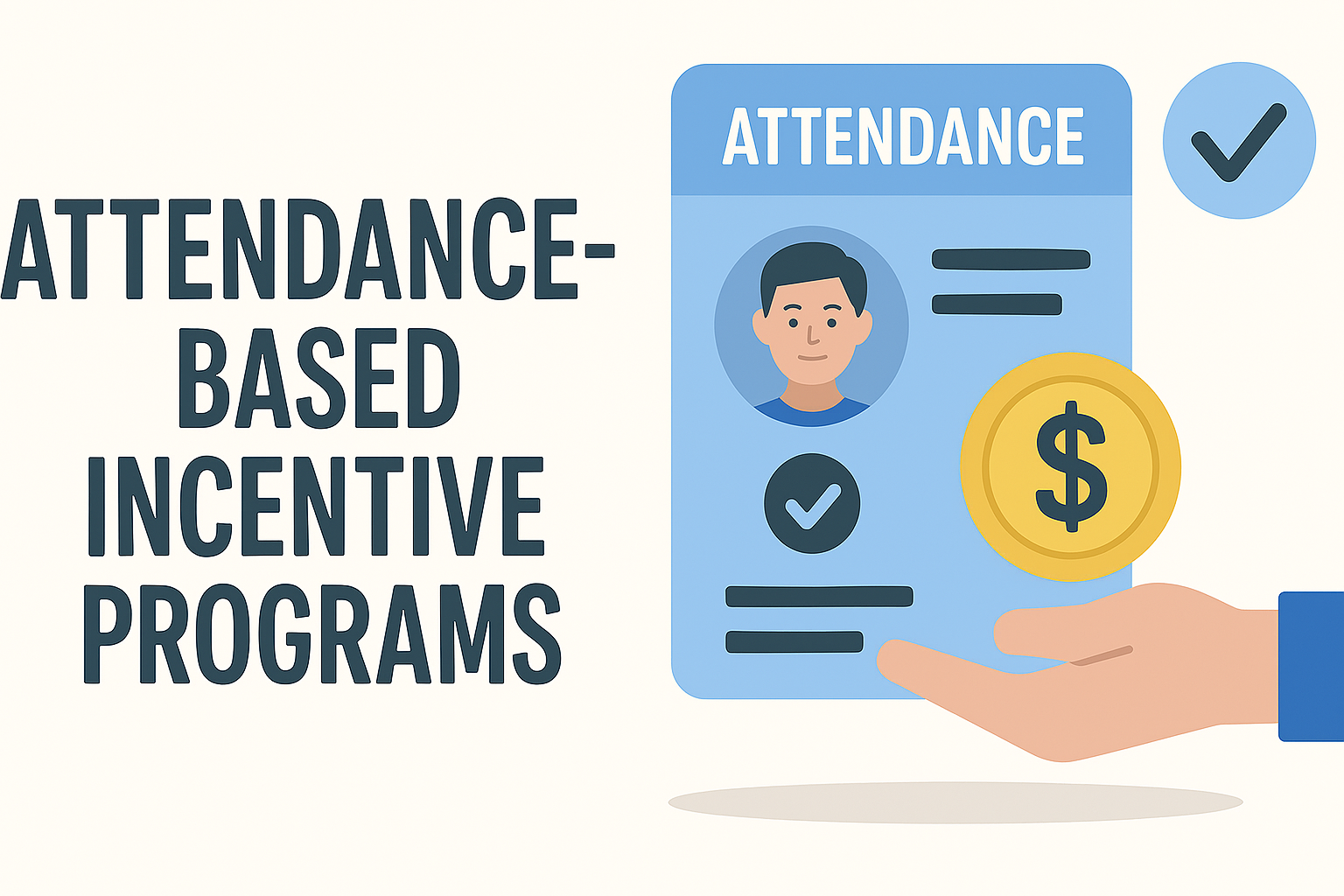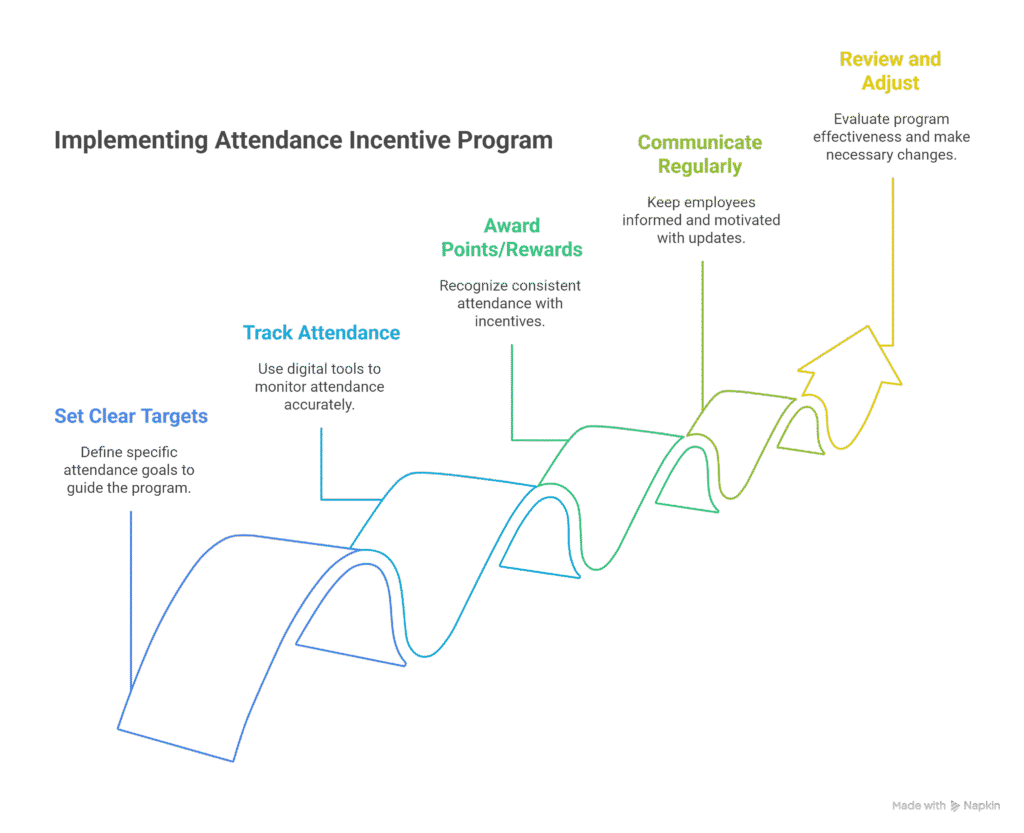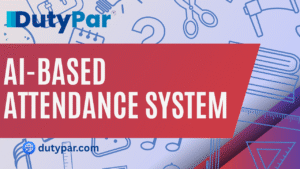
Table of contents
- What Are Attendance-Based Incentive Programs?
- How Do Attendance-Based Incentive Programs Work?
- Key Benefits of Attendance-Based Incentive Programs
- Traditional Attendance Monitoring vs. Attendance-Based Incentive Programs
- Best Practices for Implementing Attendance-Based Incentive Programs
- Real-World Success Stories
- Conclusion
Attendance is essential for any organization. When employees show up on time consistently, it drives overall success and productivity. Attendance-Based Incentive Programs reward consistent attendance and create a culture of responsibility and commitment. These programs help businesses reduce absenteeism, increase employee engagement, and boost morale.
What Are Attendance-Based Incentive Programs?
Attendance Based Incentive Programs are a benefits plan that provides employees a mechanism to receive rewards based on punctuality and on-time attendance. These plans are based on a positive approach rather than negative action to discipline employees, instead utilizing attendance monitoring programs in a positive way and providing employees the opportunity to earn rewards for meeting and exceeding a planned attendance threshold. The rewards can be dollars, time off, accolades, and/or perks.
Attendance based incentive programs accentuate workers’ reliability. Once an employee sees the potential to earn rewards through being relabel in regular attendance, tends to be punctual. Punctuality improves an employee’s performance and work ethic, and creates team spirit. Companies that offer rewards promote an environment of employees who want to be there and want to contribute and produce as a team!
How Do Attendance-Based Incentive Programs Work?
The process behind these programs is simple and transparent. Here’s a step-by-step outline:
- Set Clear Targets: Define what counts as consistent attendance. For example, a target might be 95% attendance per month.
- Track Attendance: Use digital attendance systems or biometric devices. These tools capture real-time data on when employees arrive and leave.
- Award Points or Rewards: Based on attendance records, employees earn points or trigger an incentive. For example, a perfect attendance record over a month might result in a bonus or extra day off.
- Communicate Regularly: Keep employees informed on their progress. Regular updates and leader boards can motivate individuals to improve their attendance.
- Review and Adjust: Look at the program’s performance and get feedback from employees. Adjust targets and rewards to keep the program fair and engaging.

Key Benefits of Attendance-Based Incentive Programs
Read About : AI Facial Recognition
Implementing an Attendance-Based Incentive Program can transform the workplace. Here are the main benefits:
1. Enhanced Productivity
When employees are present, work moves smoothly. Rewarding attendance motivates team members to arrive on time and ready to work. This leads to fewer disruptions and a more predictable workflow.
2. Increased Employee Engagement
Employees feel appreciated when their consistent effort is recognized. Incentives create a sense of pride and motivate individuals to maintain high attendance. Engaged employees are more likely to go the extra mile in their roles.
3. Reduced Absenteeism
A clear reward system discourages unnecessary absences. When employees know that consistent attendance brings tangible benefits, they are less inclined to miss work without a valid reason.
4. Improved Workplace Morale
Positive reinforcement builds a supportive environment. When rewards are shared among the team, it creates healthy competition and mutual encouragement. This boosts overall morale and can lead to better collaboration.
5. Better Resource Planning
Reliable attendance data helps managers plan workloads and scheduling. When absenteeism is low, teams can forecast projects and tasks more accurately. This leads to efficient resource allocation.
6. Cost Savings
High absenteeism leads to lost productivity and increased costs. Reducing these issues through incentive programs can save money in the long run. Additionally, the cost of rewards is often less than the cost of lost work hours.
Traditional Attendance Monitoring vs. Attendance-Based Incentive Programs
Below is a table that outlines the differences between traditional attendance monitoring and incentive-based approaches:
| Aspect | Traditional Attendance Monitoring | Attendance-Based Incentive Programs |
|---|---|---|
| Approach | Punitive, focused on catching absences | Reward-driven, emphasizes positive behavior |
| Motivation | Fear of penalties | Desire to earn rewards and recognition |
| Employee Engagement | Low; can foster resentment | High; boosts morale and engagement |
| Attendance Rate | Variable; often lower due to lack of incentives | Consistently higher as employees aim for rewards |
| Data Utilization | Focus on record-keeping | Uses data to drive performance improvements |
| Cost Impact | High cost from lost productivity | Lower cost due to improved efficiency and reduced absenteeism |
This table clearly shows that Attendance-Based Incentive Programs generate a positive work environment and improve attendance rates more effectively than traditional methods.
Best Practices for Implementing Attendance-Based Incentive Programs
To maximize the benefits of these programs, follow these best practices:
- Set Realistic Targets: Make sure attendance goals are achievable. Consider factors like shift patterns and local challenges.
- Communicate Clearly: Keep the program rules simple and transparent. Use regular updates so all employees understand how rewards are earned.
- Choose Meaningful Rewards: Select incentives that motivate your team. Rewards can range from monetary bonuses to extra leave days or public recognition.
- Use Reliable Tracking Tools: Leverage digital attendance systems or biometric scanners. Accurate data collection is essential for fairness.
- Review and Adjust Regularly: Collect feedback and monitor the program’s impact. Adjust the targets or rewards if needed to keep the program fresh and engaging.
- Integrate with Performance Management: Combine attendance data with broader performance metrics. This holistic approach can offer deeper insights into employee engagement.
Real-World Success Stories
Many organizations have already reaped the rewards of Attendance-Based Incentive Programs. For example:
- A manufacturing firm implemented the program and saw a 20% increase in overall productivity. Employees were motivated by bonuses for perfect attendance.
- A service-based company used attendance incentives to reduce absenteeism by 15%. They provided extra leave days as rewards, which led to improved employee satisfaction.
- A retail chain integrated digital tracking with incentive rewards. Managers reported smoother scheduling and better resource planning, leading to faster customer service.
These examples underline the effectiveness of a reward-driven approach to attendance. Companies that invest in such programs experience not only a boost in productivity but also an improvement in workplace morale.
Conclusion
Attendance-Based Incentive Programs provide organizations with a modern tool to improve employee attendance and, in some situations, engagement. These programs improve productivity, reduce absenteeism and create supportive climates by transitioning away from punitive environments to reward-based incentives.
These types of attendance programs allow organizations to craft easily measurable targets, easily trackable attendance and conduct meaningful awards that employees will recognize following their commitment to regular attendance. Data points from the attendance program can also provide managers with reliable data while establishing planned shifts and resource assignment.
Read this Reference Too : https://getsling.com/blog/employee-incentive-programs/





